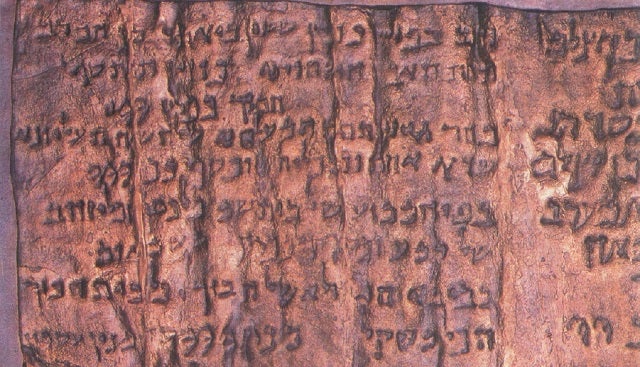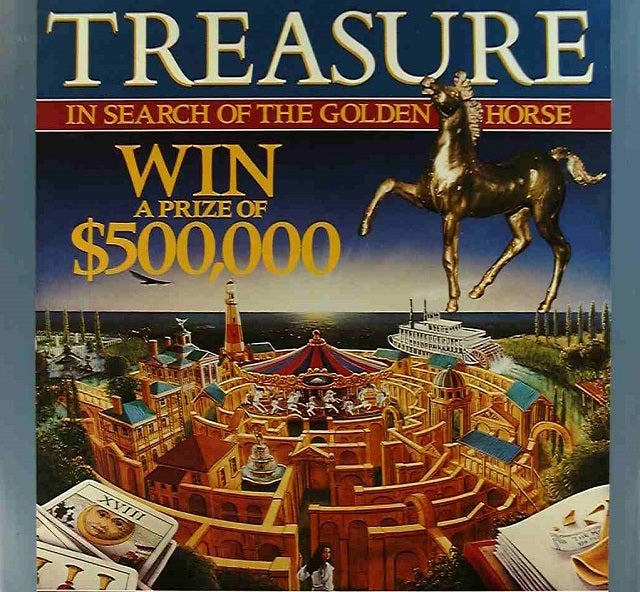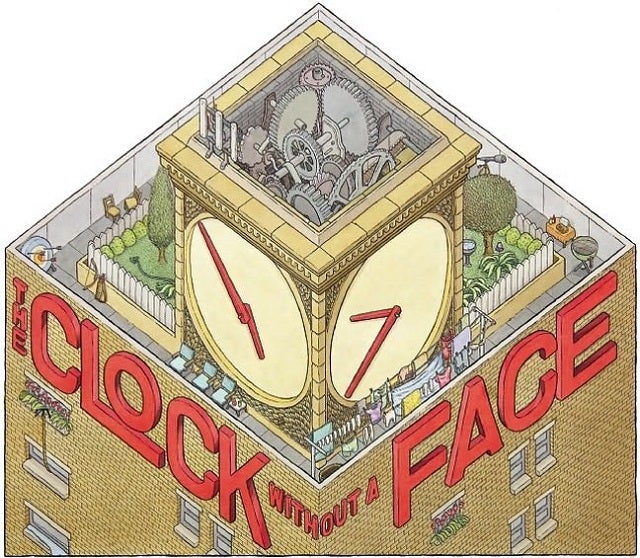
Sometimes our world seems bland in comparison to
what we read in books and see in movies and television. Where are our
chances at adventure, fame, and fortune? Well, here are 12 real-life
treasure hunts — some of which have never been solved!
Top image: Masquerade by Kit Williams.1. Forrest Fenn
In the 80s, a bout with cancer inspired "real life Indiana Jones" Forrest Fenn to fill a chest with treasures — including gold dust, gold coins, gold nuggets, Chinese jade carvings, a 17th Century Spanish gold and emerald ring - and a copy of his own book, so he could hide it in the desert before he died. He thought this would be a way to keep his memory alive.As I have gone alone in thereIt hasn't been found yet, but Fenn has some advice:
And with my treasures bold,
I can keep my secret where,
And hint of riches new and old.
Begin it where warm waters halt
And take it in the canyons down,
Not far, but too far to walk.
Put in below the home of Brown.
From there it’s no place for the meek,
The end is ever drawing nigh;
There’ll be no paddle up your creek,
Just heavy loads and water high.
If you’ve been wise and found the blaze,
Look quickly down, your quest to cease,
But tarry scant with marvel gaze,
Just take the chest and go in peace.
So why is it that I must go
And leave my trove for all to seek?
The answer I already know,
I’ve done it tired, and now I’m weak.
So hear me all and listen good,
Your effort will be worth the cold.
If you are brave and in the wood
I give you title to the gold.
What serious adventurers should remember is to not believe anything that is not in my poem or otherwise in my book. There’s some misinformation out there. For instance, I never said I buried the chest, I said only that I hid it. That is not to say it is not buried, so maybe we need to define the terms. Does ‘hidden’ mean in plain sight? What is the difference between ‘buried,’ ‘entombed’ and ‘sepultured’? What does the word ‘blaze’ in the poem mean? A horse can have a blaze on its forehead, a blaze can be scraped on a tree to mark one’s way, a blaze can mean a flame or a scar on a rock. And what about ‘water high’? Does it mean deep, or higher than normal?

2. La Chouette d'Or
In 1993, Max Valentin buried a bronze statue of an owl somewhere in France. Valentin wrote eleven clues to its location, which were accompanied by illustrations by sculptor Michel Becker. It hasn't been found yet, but Valentin said that people have come very close. He saw disturbed ground near its location and said that Dr. Gerald Gay has come the closest.Whoever does find it can exchange it for another piece originally valued at one million francs. If you want to look for it, the clues can be found here. The ability to speak French will be a huge help. But don't blow up a chapel looking for it, the way one treasure hunter did.

3. Copper Scroll
This scroll is one of the Dead Sea Scrolls. Instead of the literary works contained on the other scrolls, scroll 3Q15 appears to list locations of hidden gold and silver. It describes 64 locations where hidden caches can be found. Here are some examples:In the fortress which is in the Vale of Achor, forty cubits under the steps entering to the east: a money chest and it [sic] contents, of a weight of seventeen talents.The Copper Scroll was found on March 14, 1952 by an archaeologist. Its style of writing is very different from the other scrolls, and resembles the form of Greek inventories. It's also been dated as being from 25-75 CE or 70-135 CE. There are various theories as to what the treasure is. It could be that of the Qumran community, the Second Temple, or even the First Temple, which was destroyed by Nebuchadnezzar, the King of Babylon. And, as is the tradition for ancient discoveries, it is also believed by some to be a hoax.
In the gutter which is in the bottom of the (rain-water) tank...
In the Second Enclosure, in the underground passage that looks east...
In the water conduit of [...] the north[ern] reservoir...
4. Levi's "Go Forth" Campaign
In 2009, Levi's buried $100,000 somewhere. In theory, it was the treasure of Grayson Ozias IV, a fictional friend of Levi Strauss's nephew. In reality, it was a publicity stunt. To find it, players started with a scavenger hunt, which had people singing "When the Saints Come Marching In" on the streets of New Orleans and looking for a man in a hat in New York and saying "I am searching for leaves of grass."Completing the scavenger hunt gave participants the answers to an online quiz. A hundred of the people who completed the quiz were given a cipher leading to the location of the treasure.

5. Oak Island
Oak Island is the home of the "Money Pit," which is either an ingeniously booby-trapped treasure trove OR a natural sink hole, depending on how skeptical you are.When it was first explored in 1795, the 18 year-olds digging found a layer of flagstones and then layers of logs every 10 feet. Eight years later, the Onslow Company continued digging, and found log layers every 10 feet for 90 feet, plus layers of charcoal, putty, and coconut fibre (confusing, since coconuts are not native to Canada). At 40 feet, they allegedly found a stone with markings translated to mean: "forty feet below, two million pounds lie buried." Then the excavation flooded, and they gave up.
In 1849, another company, another set of wood, metal, clay, etc. layers and another flooding. In 1861, another association tried excavating, but the thing collapsed into EITHER a booby trap, or a natural cavern.
1931, excavations. 1960s, excavations by the Restall family ended in fatalities. Rinse, repeat, every couple of decades.
The mysterious stone with symbols describing the treasure was last seen some time in the early 20th century. It could have ended up in a fireplace. It could be the doorstop in a bookstore, who knows!
Some say it's pirate treasure. Others that it's Navy treasure. Or Marie Antoinette's jewels. Or something belonging to the Freemasons. Or documents by Francis Bacon admitting he was Shakespeare. Or that it's home of the Ark of the Covenant. So many theories, including that it's just a natural sinkhole.
Image via Out There Radio
6. The Beale Ciphers
The Beale Ciphers are a set of three encoded papers, one of which allegedly contains the location of $63 million dollars worth of treasure. The story is that, in 1820, Thomas Jefferson Beale left a box with the encrypted messages with a local innkeeper, who gave them to a friend when he died. That friend tried to decode the messages, managing to get one describing the contents of the treasure and a general location. He published a pamphlet in 1885 with the ciphers.The deciphered cryptogram reads:
I have deposited in the county of Bedford, about four miles from Buford's, in an excavation or vault, six feet below the surface of the ground, the following articles, belonging jointly to the parties whose names are given in number three, herewith: The first deposit consisted of ten hundred and fourteen pounds of gold, and thirty-eight hundred and twelve pounds of silver, deposited Nov. eighteen nineteen. The second was made Dec. eighteen twenty-one, and consisted of nineteen hundred and seven pounds of gold, and twelve hundred and eighty-eight of silver; also jewels, obtained in St. Louis in exchange for silver to save transportation, and valued at thirteen thousand dollars. The above is securely packed in iron pots, with iron covers. The vault is roughly lined with stone, and the vessels rest on solid stone, and are covered with others. Paper number one describes the exact locality of the vault, so that no difficulty will be had in finding it.It's decoded using the Declaration of Independence. Someone call Nicholas Cage!
(And yes, like the Money Pit, there are people who believe it's just a hoax. Joe Nickell's 1982 analysis used historical records to cast doubt on Beale's existence and linguistic evidence to show that the documents are false. Others have argued about whether it's real or fake, presenting all sorts of evidence.)
7. Michael Stadther's A Treasure's Trove
After selling his banking-software company, Michael Stadther wrote and self-published A Treasure's Trove. Released in 2004, the book is the story of an evil fairy who turns animals into crystals and Zac the woodcarver, who fights to free a dying forest. The book had clues to the locations of 18-carat gold leaves, each worth $1,000. The leaves could be exchanged for gem-encrusted statuettes of the book's characters — worth between $8,500-450,000. Or cash. They could also be exchanged for cash.
8. Chinese Gold Bar Mystery
So, seven gold bars are allegedly issued to the Chinese General Wang. The bars have images, Chinese writing, some kind of script writing, and Latin letters stamped onto them. The Latin letters are some sort of cryptogram, while the Chinese has been translated and refers to a $300,000,000 transaction of some sort.The idea is that the bars are certificates for a bank deposit in some U.S. bank. If they can be deciphered, they may show a claim for the deposit. If you want to try your hand at deciphering them, go here.

9. Masquerade
Publisher Tom Maschler challenged Kit Williams to "do something no one has ever done before" with a children's book. Williams wrote and illustrated Masquerade, which told the story of Jack Hare, a rabbit, who is carrying a gift of treasure from the moon to the sun. But when he gets there, the treasure is gone. But the 15 detailed paintings in the book hold clues to its location.Williams created an 18-carat gold and jeweled hare pendant. The pendant went in a ceramic hare-shaped container. The container was inscribed with "I am the Keeper of the Jewel of MASQUERADE, which lies waiting safe inside me for You or Eternity". On August 7, 1979, he buried it in England.
In 1982, Williams revealed the winner to be Ken Thomas. However, in 1988 The Sunday Times exposed Ken Thomas as Dugald Thompson, whose business partner's girlfriend was an ex of Williams. The ex revealed the approximate location to Thomas/Thompson, who then found the treasure in a dirt pile left behind by the two professors who had actually solved the riddle.
The solution to the mystery is insanely complicated. You can either try to solve it yourself or look it up on Wikipedia.

10. Treasure: In Search of the Golden Horse
Inspired by Masquerade, in 1984, Intravision and filmmaker Sheldon Renan created a puzzle that was both published in a book and direct-to-video movie. Solving the rebus in the story would lead hunters to a one kilogram gold horse statuette buried somewhere in the United States. Finding the horse before May 26, 1989 also entitled the winner to $500,000 in a safe deposit box locked with a key hidden in the horse.The deadline passed and the prize was donated to charity. But later, Nick Boone and Anthony Casteneda dug up a vial with a congratulations message in Colorado. However, the conclusions the two drew to find the vial looked like they defied logic or not defined by the puzzles. Instead, the theory is that the promoters of the contest made some changes that made it unsolvable, so the promoters guided Boone and Casteneda to the vial in order to put the contest to bed.

11. The Clock Without a Face
In 2010, McSweeney's published The Clock Without a Face by Eli Horowitz and Mac Barnett. The book is about the theft of the Emerald Khroniker's 12 jeweled numbers. Clues to whereabouts of the numbers and the thief are in both the text and Scott Teplin's illustrations.Twelve actual emerald-studded numbers were hidden all over the United States, with readers encouraged to find them. Eventually all but one of the numbers were found.
Horowitz really intended for them to be found, invoking Masquerade in an interview with Salon:
“We definitely like the idea of people getting out of the house and getting their hands dirty,” says “Clock” co-author Eli Horowitz. “Though I’m a little nervous that misguided expeditioners will accidentally exhume old grandmothers.”
[. . .]
While Horowitz won’t confirm or refute any current theories, he insists the treasure is very much within reach. He guesses the first number will be found within weeks, and all of them within months. “This is not an endurance test,” he says. “I have no hope for a ‘Masquerade’ situation.”
12. The Unicornis Manuscripts
Published in 1983 and again in 2008, The Unicornis Manuscripts is the story of the work of a fictional 15th Century man named Magnalucius and the origins and movements of unicorns. In the story are clues to where author Michael Green buried a silver Spiral Horn. Within the world of the book, Horn seekers are given the warning:O Reader: If thou art neither scribe nor sacrificer, cast not thy gaze upon this book, for it contains secret teachings useful only to the few and troubling to the many. And if thou seekest only mere amusement, read no further. But if thou art an earnest pilgrim on the path of Life, then open, read and ponder.'And the book explains why the Horn is hidden:
No man knows to whom the Horn should go. That ever and again it must be hidden so that, in obscurity, it may draw forth its rightful Keeper and so be ransomed.No one has found it yet, and it looks like no one will. Before the 2008 version was published, Green went to check on the Horn and found that it was now covered in water.
A Treasure's Trove, Masquerade, Treasure: In Search of the Golden Horse, The Clock Without a Face, and The Unicornis Manuscripts are all "armchair mysteries." More of them, and whether they have been solved, remain unsolved, or are abandoned can be found here.

No comments:
Post a Comment